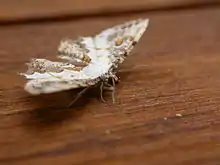Europlema desistaria
Europlema desistaria is a species of moth of the family Uraniidae first described by Francis Walker in 1861. It is found in India, Sri Lanka, Myanmar, Thailand, Taiwan, Borneo, Sulawesi, Flores and Queensland.[2][3]
| Europlema desistaria | |
|---|---|
 | |
 | |
| Scientific classification | |
| Kingdom: | |
| Phylum: | |
| Class: | |
| Order: | |
| Family: | |
| Genus: | |
| Species: | E. desistaria |
| Binomial name | |
| Europlema desistaria | |
| Synonyms | |
| |
Description
The moth's wingspan is about 24 mm. Its forewings have an evenly curved outer margin, and its hindwings have slight tails at veins 4 and 7. Its head and collar are fuscous. Its thorax and the first segment of its abdomen are white; the other segments are fuscous. Its forewings are thickly speckled and striated with brown, fulvous and black, the inner area white slightly marked with fuscous. There is a white spot on the cilia. Its hindwings have a white costal area, while the rest of the wing is fulvous and striated with black. The outline between the two areas is very irregular. A laden grey marginal line can be seen from the tail at vein 7 to anal angle.[4]
The adult moths have a complex wing pattern consisting of shades of brown. There is a ragged white inner margin on each forewing and along the costa of each hindwing.[5]
References
- Australian Faunal Directory
- Savela, Markku. "Europlema desistaria (Walker, 1861)". Lepidoptera and Some Other Life Forms. Retrieved July 26, 2018.
- The Moths of Borneo
- Hampson, G. F. (1895). The Fauna of British India, Including Ceylon and Burma. Vol. Moths Volume III. Taylor and Francis – via Biodiversity Heritage Library.
- Herbison-Evans, Don & Crossley, Stella (6 March 2013). "Epiplema desistaria (Walker, 1861)". Australian Caterpillars and their Butterflies and Moths. Retrieved 26 July 2018.